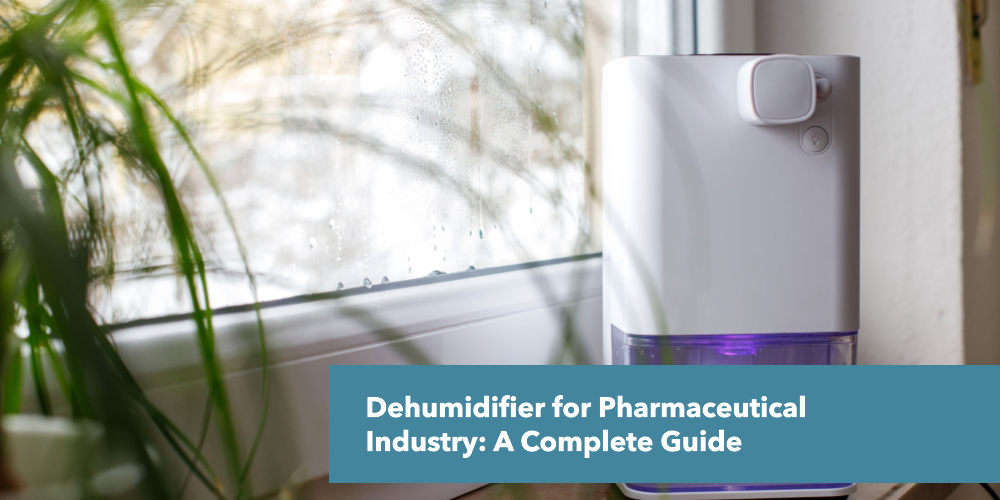What are the Uses of the Dehumidifier for the Pharmaceutical Industry ?
Dehumidifiers in the pharmaceutical industry serve critical roles to ensure product quality, safety, and compliance. Below are their key uses with precise applications:
Moisture Control in Drug Stability
You use dehumidifiers to maintain relative humidity (RH) levels between 30–50% in storage and production areas. This prevents moisture-sensitive drugs (e.g., tablets, powders) from degrading, ensuring shelf-life stability. Some formulations require stricter control (e.g., <20% RH) to avoid hydrolysis.
Microbial Growth Prevention
By keeping RH below 60%, dehumidifiers inhibit bacterial and fungal growth in raw materials and finished products. This aligns with WHO and USP guidelines, which mandate low-humidity conditions to avoid contamination.
Regulatory Compliance
You rely on dehumidifiers to meet FDA, WHO, and EMA standards. For example, USP chapters <795> and <797> require RH levels ≤35% for sterile compounding areas to ensure product safety.
Raw Material Protection
Hygroscopic materials (e.g., APIs, excipients) absorb moisture, altering weight or potency. Dehumidifiers maintain 15–30% RH in warehouses to preserve material integrity and avoid batch rejection.
Cleanroom Environment Maintenance
In ISO-classified cleanrooms, you maintain 45±5% RH to prevent static buildup and ensure operator comfort while adhering to ISO 14644 standards.
Packaging Integrity
Dehumidifiers ensure 10–30% RH during blister packaging or bottling to prevent moisture ingress, which could compromise seal quality or label adhesion.
What is the main purpose of a dehumidifier in the pharmaceutical industry?
The main purpose of a dehumidifier in the pharmaceutical industry is to optimal humid level and remove excessive moisture from the air which results in healthier and more comfortable environment.
How to Control Humidity in the Pharmaceutical Industry?
Controlling humidity in the pharmaceutical industry requires precise strategies and equipment to maintain product quality and compliance. Here’s how you achieve it:
Use HVAC Systems with Dehumidification
Install HVAC systems integrated with desiccant or refrigerant dehumidifiers to maintain 30–50% RH in general areas. For moisture-sensitive zones (e.g., sterile labs), stricter control (<20% RH) is achieved using low-dew-point systems.
Monitor with Hygrometers
Deploy digital hygrometers or data loggers to track real-time humidity levels. Calibrate devices regularly to ensure accuracy (±2% RH error margin) as per pharmacopeial standards.
Seal Production Areas
Ensure airtight insulation of walls, doors, and vents to prevent external moisture ingress. Use vapor barriers in storage areas to stabilize internal conditions.
Control Material Handling
Store hygroscopic raw materials (e.g., APIs) in humidity-controlled chambers (15–30% RH) and use nitrogen purging in packaging lines to eliminate moisture exposure.
Maintain Cleanroom Standards
In ISO-classified cleanrooms, combine HEPA filtration with humidity control systems to sustain 45±5% RH, minimizing static and microbial risks.
Follow Regulatory Guidelines
Adhere to USP, FDA, and WHO requirements (e.g., ≤35% RH for sterile compounding per USP <797>) and validate systems annually to ensure compliance.
By combining these methods, you ensure stable humidity levels, safeguarding product efficacy, shelf life, and regulatory compliance.
What is the humidity limit in pharmaceutical Industry?
Humidity limits in pharma vary by process and product requirements. Below are key thresholds:
General Storage & Production Areas
30–50% RH: Standard range to protect most drugs from moisture degradation and ensure stability.
Moisture-Sensitive Products
<20% RH: Critical for hygroscopic APIs, lyophilized products, or formulations prone to hydrolysis.
Sterile Compounding (USP <797>)
≤35% RH: Mandated to reduce contamination risks during sterile preparation.
Cleanrooms (ISO 14644)
45±5% RH: Balances static control, operator comfort, and microbial prevention.
Packaging Zones
10–30% RH: Prevents moisture ingress during blister packing or bottling to maintain seal integrity.
Raw Material Storage
15–30% RH: Protects hygroscopic excipients and APIs from clumping or potency loss.
Regulatory Limits:
Microbial growth risk increases above 60% RH (per WHO guidelines).
USP, FDA, and EMA enforce context-specific thresholds; deviations can lead to batch rejection or non-compliance.
You must tailor limits to product needs and validate systems to ensure consistency.
Contact us for the Dehumidifier Services in Pakistan a t Breeze Marketing
Reach out to Breeze Marketing for top-notch dehumidifier supplier in Pakistan. Our expert team ensures efficient installation and reliable maintenance. Contact us now to enhance your indoor air quality and comfort.

